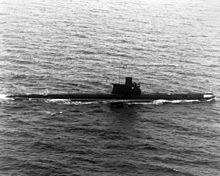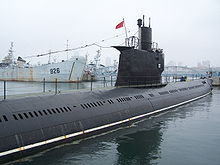
An attack submarine or hunter-killer submarine is a submarine specifically designed for the purpose of attacking and sinking other submarines, surface combatants and merchant vessels. In the Soviet and Russian navies they were and are called "multi-purpose submarines". They are also used to protect friendly surface combatants and missile submarines. Some attack subs are also armed with cruise missiles, increasing the scope of their potential missions to include land targets.

The Type 094 is a class of nuclear ballistic missile submarines developed by China for the People's Liberation Army Navy Submarine Force. The Type 094 succeeds the Type 092 submarine and precedes the Type 096 submarine, which is under development.
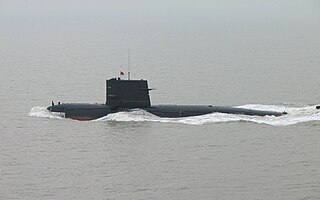
The Type 039 submarine is a class of diesel-electric submarines of the People's Liberation Army Navy. The class is the first diesel-electric submarine to be made in China and also the first Chinese made diesel-electric submarine to use the teardrop hull shape. Altogether thirteen vessels were completed to the Song Class design between 1999 and 2006, with three variants as the type developed.
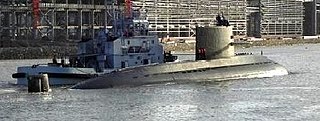
The Type 039A submarine is a class of diesel-electric submarine in China's People's Liberation Army Navy. It is China's first AIP powered submarine and presumed to be one of the quietest diesel-electric submarine classes in service. This class is the successor of the Type 039 submarine. The official Chinese designation is 039A as the ship is based on the 039 class, but as the 039A has very little resemblance to the 039 it is commonly referred to as the Type 041. The class is designed to replace the aging Type 033 and the older Type 035 submarines that previously formed the backbone of the conventional submarine force.
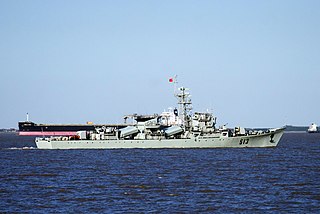
The Type 053 is a family of Chinese frigates that served with the People's Liberation Army Navy Surface Force, and a small number of foreign navies.
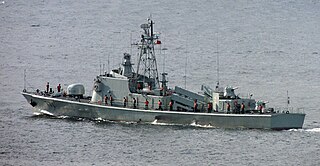
The Type 037 corvette is a series 400–500 ton corvette type classes in service with the People's Liberation Army Navy. Unlike western navies, the People's Liberation Army Navy does not have dedicated patrol boats in its inventory. Instead, a large variety of corvette type classes, in the form of missile boats and submarine chasers fulfill the tasks of patrolling China's territorial waters. The Egyptian Navy operates eight vessels.

The People's Liberation Army Navy Submarine Force (PLANSF) is the submarine service of the People's Liberation Army Navy. It consists of all types of submarines in operational service organized into three fleets: the North Sea Fleet, the East Sea Fleet, and the South Sea Fleet. Submarines have long been one of the three focuses of the People's Liberation Army Navy, and when the decision was made in late 2006 to concentrate on building other principal surface combatants to strengthen the air defense and to further delay the construction of aircraft carriers due to insufficient air cover, submarines will continue to play the lead dominant role in the assault force for the PLAN. Currently, PLANSF operates a fleet of 66 submarines which include nuclear as well as conventional submarines.
Siping (519) was a Type 053H frigate of the People's Liberation Army Navy. On 28 July 2010, she was renamed to Lushun.
The Type 035 submarine is a class of diesel-electric submarines of the People's Liberation Army Navy. The Type 035 is a heavily improved redesign of the older Type 033 submarines, which were built in China from 1962 to 1984.

Huang Xuhua is a Chinese mechanical engineer, and the second chief designer for the country's first generation of nuclear submarines. He is director emeritus of the Wuhan-based 719 Research Institute of China Shipbuilding Industry Corporation, and is an academician of the Chinese Academy of Engineering. His name was classified until 1987.

Peng Shilu was a Chinese nuclear engineer. Hailed as "the father of China's nuclear submarines" and the "father of China's naval nuclear propulsion", he was the first chief designer of the country's nuclear submarine project, directing his team to build China's first generation of nuclear submarines. He was also the main designer for China's first nuclear power plants, and was an academician of the Chinese Academy of Engineering. He served as deputy minister for China's Ministry of Shipbuilding Industry, and Ministry of Water Resources and Electric Power.

Changzheng 1 (401) is a Type 091 nuclear attack submarine of the People's Liberation Army Navy.

Changcheng 237 is a Type 033 submarine of the People's Liberation Army Navy.
Changcheng 274 is a Type 6633 submarine of the People's Liberation Army Navy.
Changcheng 303 is a Type 033 submarine of the People's Liberation Army Navy.
Changcheng 349 is a Type 033 submarine of the People's Liberation Army Navy.
Changcheng 279 is a Type 033 submarine of the People's Liberation Army Navy.
Changcheng 280 is a Type 033 submarine of the People's Liberation Army Navy.
Changcheng 353 is a Type 035 submarine of the People's Liberation Army Navy.

